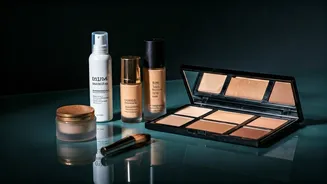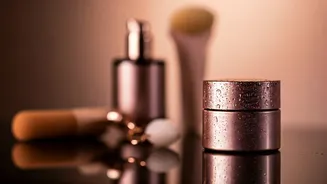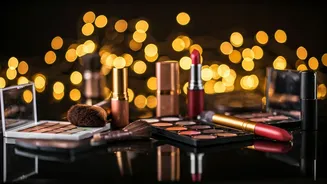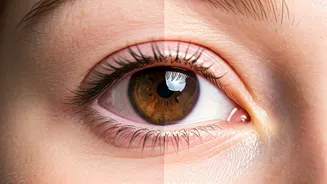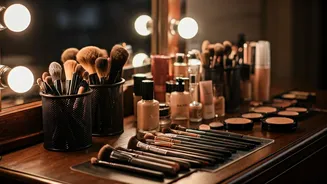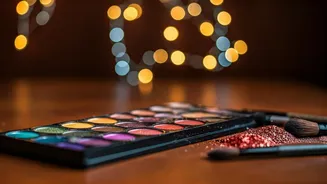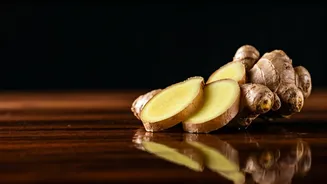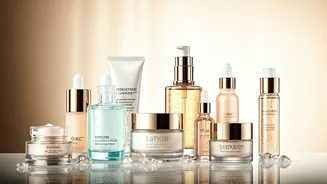Cleanse and Exfoliate
The foundation of a great makeup base starts with a clean slate. Begin with a gentle cleanser to remove impurities, oil, and any residual makeup. Choose
a cleanser suited for your skin type – hydrating for dry skin, oil-controlling for oily skin, and gentle for sensitive skin. Following cleansing, exfoliate your skin one or two times a week. Exfoliation helps remove dead skin cells that can cause a patchy makeup application. Use a chemical exfoliant with ingredients like AHAs or BHAs, or a gentle physical scrub, depending on your skin's needs. Exfoliating ensures a smooth surface for your makeup to adhere to, preventing it from caking or settling into fine lines and pores. Always follow up with a toner to balance the skin's pH levels.
Hydrate and Moisturize
Hydration is crucial for a plump, healthy, and makeup-ready base. After cleansing and toning, apply a hydrating serum. Look for serums with hyaluronic acid, which attracts and retains moisture. Let the serum absorb fully before moving on to moisturizing. Choose a moisturizer suitable for your skin type. Dry skin benefits from rich, emollient creams, while oily skin may prefer lightweight, oil-free lotions or gels. Moisturizing creates a smooth, hydrated surface, preventing the makeup from clinging to dry patches and ensuring a flawless finish. Give the moisturizer time to absorb before applying any makeup to allow the product to fully work its magic.
Prime Your Canvas
Priming is the secret weapon for a long-lasting and flawless makeup base. A makeup primer creates a barrier between your skin and your makeup, helping to smooth the skin's texture, minimize the appearance of pores and fine lines, and control oil production. There are various types of primers available, including hydrating, mattifying, color-correcting, and pore-blurring primers. Choose a primer that addresses your specific skin concerns. For example, if you have dry skin, a hydrating primer will provide an extra layer of moisture, while a mattifying primer will help control shine if you have oily skin. Apply a thin layer of primer all over your face, or targeted areas, like the t-zone where your skin tends to produce more oil. Allow the primer to set for a few minutes before applying foundation.
Foundation Application Techniques
Choosing the right foundation and applying it correctly is key to achieving a flawless makeup base. Select a foundation formula that matches your skin type and provides the desired coverage. For a natural look, opt for a lightweight foundation or tinted moisturizer. For fuller coverage, a more full-coverage foundation is better. Using the right tools is also critical. A makeup sponge, brush, or your fingers can be used to apply foundation. For a natural finish, use a damp makeup sponge and gently bounce it over your skin, blending in a dabbing motion. Brushes offer more precision and can give a more airbrushed effect. Apply the foundation starting in the center of your face and blend outwards, ensuring an even application. Build coverage gradually to avoid a cakey look.
Conceal and Correct
Concealers are vital to correcting imperfections and highlighting your best features. Use a color-correcting concealer to neutralize any discoloration, such as redness, dark circles, or hyperpigmentation. Green concealer can help counteract redness, peach or orange concealers can cancel out dark circles, and yellow concealers can brighten the under-eye area. Apply concealer after foundation, targeting areas where you need extra coverage, such as blemishes or dark circles. Choose a concealer formula that matches your skin type. Use a concealer that’s lighter than your foundation to brighten areas such as under the eyes. Blend the concealer thoroughly using a makeup sponge or brush, ensuring a seamless transition with your foundation.
Set with Powder
Setting your makeup with powder is essential for locking in your base and ensuring it lasts throughout the day. Loose powder or pressed powder works great for this step. Loose powder typically offers a more natural finish, while pressed powder is easier for touch-ups on the go. Use a fluffy brush to lightly dust powder all over your face, focusing on areas prone to oiliness, such as the T-zone. This helps absorb excess oil and sets your foundation and concealer. For a more airbrushed look, try the 'baking' technique, where you apply a generous amount of translucent powder under your eyes and other areas, letting it sit for a few minutes before dusting off the excess. This technique creates a flawless, crease-free base.
